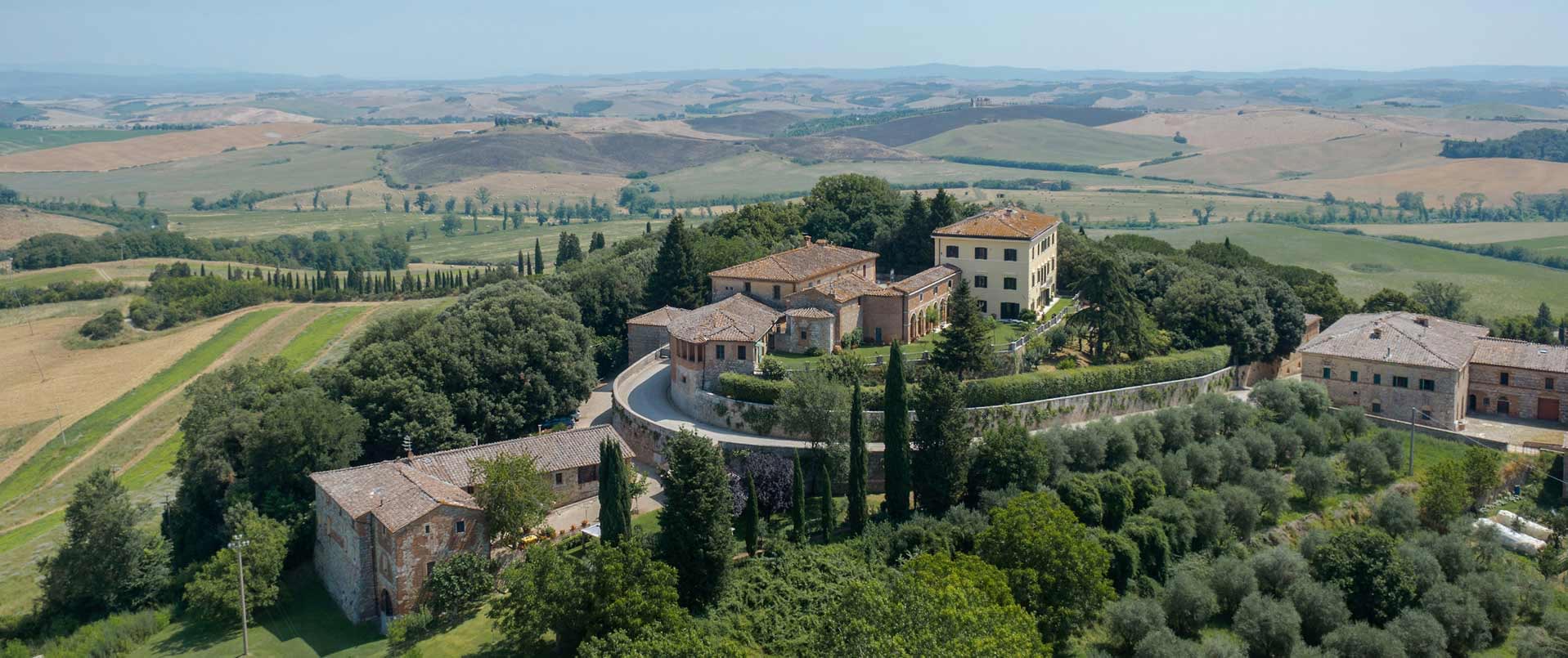
Villa Vitalba Lurani Cernuschi is a spacious 18th-century building, brimming with natural light and overlooking a vast garden graced by centuries-old trees and a tennis court. Stepping inside the ground floor, a generous veranda extends a warm welcome to guests all year round. The billiard room contains a rich library full of books and manuscripts, while the adjoining reception rooms are adorned with age-old frescoes, preserving the timeless allure of this historical residence.
The large kitchen, which features an oval table and walnut cabinets, invites visitors to savour the warmth and authenticity of a home still cherished by its owners. The somewhat austere appearance of this old family abode is softened by an ambiance that consistently radiates a sense of warmth, familiarity and hospitality. Everyone who visits Almenno San Salvatore for the first time is captivated by its atmosphere and is always eager to return.
Within the same property, surrounded by vineyards, is the beautiful Convent of San Nicola, a complex that includes the Church of San Nicola, the cloister and the Lurani Cernuschi wine cellar, where it is possible to taste and purchase wine produced with grapes cultivated in the surrounding vineyards.
Villa Vitalba is ideal for exclusive groups of up to 20 people and is also listed on the Airbnb platform. The Villa can be rented out for individual private events, such as conferences, concerts, weddings and company team-building sessions, as well as meetings, photo shoots and art masterclasses.
The history of Villa Vitalba Lurano Cernuschi
Villa Vitalba Lurani Cernuschi is located on the Umbriana hill in the ancient village of Almenno San Salvatore, in the province of Bergamo within the ancient region of Lemine Superiore. This architectural ensemble comprises the main villa, the farmstead, a quaint rustic courtyard and a garden. Originally designed with two wings forming an ‘L’ shape during the 18th century, the Villa underwent significant renovations in 1830 under the supervision of architect Giacomo Bianconi (Milan, 1780 – Bergamo, 1858), who was a member of the Accademia Carrara in Bergamo. It was during this period that the Villa acquired its present neo-Classical appearance. The north-facing façade along the road exudes simplicity and austerity, while the broad south-facing façade, which opens onto the park, has an expansive, perfectly symmetrical tripartite design.
The central section of the building is elevated in relation to the side wings and has a ground-floor portico enclosed by five high glass windows which lead, via a short flight of steps, to the large vaulted veranda. Adorning the exterior are four sandstone pedestals, each bearing statues portraying mythological subjects. Positioned at the heart of the veranda, a grand double-flight staircase ascends to the first floor. Both the ornate wooden ceiling embellishments and the elaborate wrought-iron railings harken back to 18th-century craftsmanship, providing a glimpse into the architectural heritage of the era.
On the ground floor, the west wing, which underwent significant restoration in 1830, comprises four rooms. Of particular note is the Bird Room, a spacious square room elegantly decorated with depictions of landscapes, exotic animals and numerous reproductions of various bird species on its walls and ceilings. Quirino Salvatoni, a renowned decorator from Gandino and a passionate ornithologist, meticulously reproduced over 50 bird species in various flight positions and perched on plants, showcasing both exotic and native Lombard flora. This imaginative presentation creates a unique and vibrant eco-system where nature seems to come to life.
In the adjacent room, major conservation work carried out in 2016 by harpsichord restorer Marcellino Grillo has restored and given new voice to the precious Viennese fortepiano, originally purchased by Paolo Cristoforo Vitalba in the early 19th century from the Spada workshop in Bergamo. This fortepiano is now preserved in the ‘Sala Rossa’ or Red Room, where chamber music concerts are also held today. On the north side, in the Billiard Room, an extensive collection of antique books, musical scores and opera librettos are displayed in the numerous bookshelves.
Accessing the main ‘piano nobile’ first floor via the staircase, there is a wide gallery with ceilings decorated by the Salvatoni workshop (Quirino and his son Giambattista) that is decorated with portraits, 18th-century gilded mirrors and Murano blown glass chandeliers. The Gallery leads to the master bedrooms of the two main apartments, which largely preserve their original furnishings, including an imposing four-poster bed with purple brocade and gilded wooden inserts. Some of the rooms in the eastern wing feature 18th-century-style ceilings with the underlying high band decorated with flowers and bucolic subjects in pastel tones. On the second floor, a long corridor runs lengthwise through the Villa, providing access to the numerous guest bedrooms and the apartments that were formerly reserved for the staff quarters.
On the same estate, surrounded by secular vineyards and adjacent to the Villa, stands the 16th–century complex of the former Augustinian convent of Santa Maria della Consolazione, also known as San Nicola. In the late 15th century, a plague epidemic led the inhabitants of ancient Lemine to make a solemn vow to erect a ‘chapel’ in honour of Saints Sebastian and Rocco, the traditional protectors against infectious diseases, in the hope of ending the contagion. The project was executed by the Order of the Augustinian Hermits, who constructed the convent and the Church of Santa Maria della Consolazione between 1488 and 1518. Richly decorated with frescoes and important paintings, such as ‘The Holy Trinity with Augustine and Blessed George of Cremona’ by Andrea Previtali (1517) and a polyptych by Antonio Boselli (now housed at the Accademia Carrara art museum in Bergamo), the church also houses a rare example of an Antegnati organ (1588), preserved intact in all its original parts, and, thanks to a recent restoration, still used today for religious functions and concerts of Baroque music.
In 1773, Bergamasque nobleman Paolo Defendo Vitalba, already the owner of the Villa, purchased the former convent and the surrounding lands from the Venetian Republic. The property passed down through inheritance to Clarina Barca, the niece of Maria Candida Vitalba Barca, and in the second half of the 19th century, through Clarina’s marriage to Agostino, to the Milanese family of Counts Lurani Cernuschi, whose direct descendants are the present owners. From the late 18th century until the mid-20th century, the cloister was used as a rural outbuilding and as a dwelling for the sharecroppers who cultivated the properties of the noble Vitalba families. Today, the ground floor of the former convent is home to the ‘La Frasca’ restaurant and the Lurani Cernuschi Winery, while on the first floor the ancient cells of the friars are open to the public for guided tours.
The Church of Santa Maria della Consolazione is part of the Romanesque Circuit of Almenno, which includes other precious monuments such as the Temple of San Tomè, the Church of San Giorgio and the Sanctuary of Madonna del Castello.
Staying at the villa
This exceptional private residence is ideal for families or groups who appreciate spending their leisure time in the natural beauty of the countryside. The Villa welcomes only one group at a time, offering exclusive access of all the spaces.
Experiental cooking classes
Milanese chef and close family friend, Benedetta Manetti, organises wonderful authentic Italian cooking classes for groups of up to 12 people in the Villa’s spacious kitchen, providing a memorable and hugely enjoyable experience that combines learning with fun, and transports participants to an atmosphere of times gone by.
Wine tasting
The Lurani Cernuschi Cellar also organises guided tours of the vineyards, the cellar and the church upon request, along with tastings of the 8 wines produced on the estate, accompanied by platters of cold cuts and cheese.
The garden
The English-style garden is adorned with several statues, including three grotesque dwarfs attributed to sculptor Pirovano. Tall centuries-old trees, including an exceptionally large ‘Lyriodendrum tulipifera’ tulip tree, encircle a large lawn that extends as far as the Villa, making it an ideal venue for outdoor events, small symbolic ceremonies and romantic picnics.
Guides tours and visits
Villa Vitalba is a member of the Bergamo Historical Residences association, which organises a calendar of rotating guided tours on sundays in april, may, september and october.
For groups of a minimum of 15 visitors, it is possible to request a guided tour of Villa Vitalba Lurani Cernuschi and the Convent of San Nicola. Visits are conducted in italian, english and German. Within the former convent is the popular La Frasca Restaurant, which is open for lunch and dinner every day except monday.
The Lurani Cernuschi Winery can also be visited and includes wine tasting and the sale of the wines grown on the estate’s vineyards.
 Accommodation
Accommodation
 Co-Working
Co-Working
 Film sets
Film sets
 Gardens
Gardens
 Medium and long-term rentals
Medium and long-term rentals
 Parks
Parks
 Private events
Private events
 Residences
Residences
 Spirituality
Spirituality
 Visits
Visits
 Weddings
Weddings
 Cooking courses
Cooking courses  Cultural tourism
Cultural tourism  Cyclotourism
Cyclotourism  Excursions
Excursions  Gardens
Gardens  Hiking
Hiking  Historic Homes open to visitors
Historic Homes open to visitors  Nature
Nature  Restaurants
Restaurants  Sports
Sports  Tasting
Tasting  Walking itineraries
Walking itineraries  Wine tourism
Wine tourism  Winery
Winery